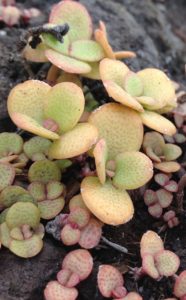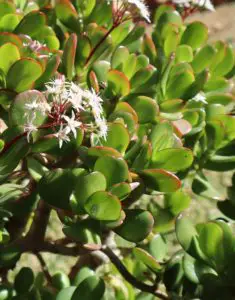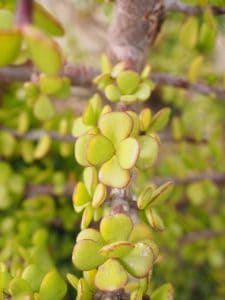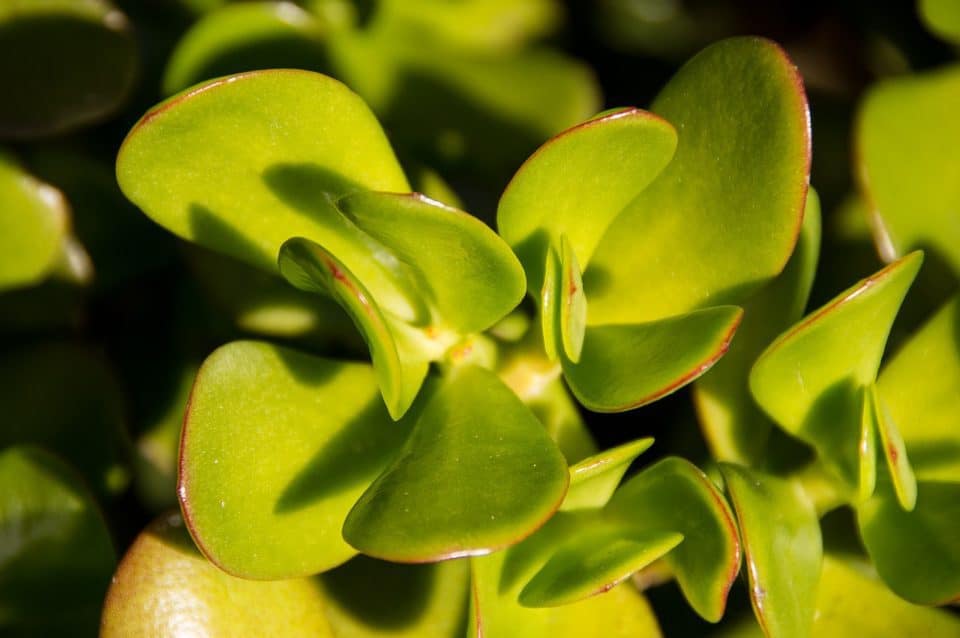Some links in the post are affiliate links and I get a commission from purchases made through some links found in the post.
The ogre ear plant is a Jade plant subspecies that has its origins in South Africa and Mozambique.
This succulent is praised for its shiny and smooth leaves that grow in opposite pairs, creating quite the aesthetic for a clean and simple look.
The plants come in a range of varieties, boasting of different hues, thus giving you a wide selection when it comes to what works for your indoors.
It gets even better given that the leaves also change based on the environment in which they live. They turn red on the edges in direct sun, and in the shade, they turn dark green.
Types of Jade Plants
The jade plant goes by a myriad of names such as the lucky plant, money tree, friendship tree, etc.
The ease of care routines and the beauty of this plant have earned it a place in offices, businesses, and homes.
Today, we look at the ogre ear jade plant. But before that, let’s cover the other types at a glance.
Crassula Ovata (Gollum Jade Plant)

This species is the most common and is characterized by shiny, thick, and fleshy leaves that occur in pairs along the stem.
The leaves change depending on their exposure to sunlight, as earlier indicated.
This plant also goes by names such as Finger plant, Shrek’s ears, and Ogre’s ears because of its leaf shape.
The leaves feature tubular shapes with suction-like ends, much like Shrek’s ears.
Golden Jade Plant
Instead of the greenish or reddish hues characteristic of the ogre ear jade, this one boasts of yellow-green leaves with a golden tint.
Silver Jade Plant
With leaves resembling silver dollars, it’s not hard to see where this the silver jade plant gets its name. It also goes by money plant and Chinese Jade.
Dwarf Jade
Thanks to its slow and stunted growth pattern, this plant with yellow-green leaves grows to much smaller heights than its counterparts. And it stays that way.
Variegated Jade Plant
The light green-yellowish striped leaves have earned this plant the ‘lemon and lime’ tag.
In bright sunlight, the leaves turn a lovely pinkish hue. The aesthetic value increases even more with the onset of star-shaped flowers with white shades.
Why is my Ogre Ear Wrinkly?
The care practices for Jade plants are quite similar such that what works for the goose may work for the gander.
However, it always helps to be specific to your plant’s needs, more so if there are signs of trouble.
In this case, we will look at why your ogre ear plant may exhibit wrinkly leaves instead of smooth, shiny, and fleshy leaves. It may or may not apply to other jade species.
Naturally, your jade leaves should be fleshy and thick. If this is not the case and your ogre ear plant is wrinkly. you could be dealing with any of the following:
1) Natural reponse to climate
2) watering techniques
3) Pest infestation
4) Rootbound plant
1) Natural Response to Climate
In wet seasons, the jade plant stores water in its leaves, hence the plump look.
But in dry times, the plant directs the water in the leaves to the roots to account for the reduced water availability.
This change is more apparent in outdoor plants that rely on rain to maintain their looks.
The drier the soil is, the more water the roots will draw from the leaves, resulting in thin and wrinkly leaves for your ogre ear.
The beauty of this process is that it enables the root to remain healthy such that it can support the growth of new leaves when the wet season begins.
Solution to Natural Response to Climate
Should you allow your plant to reach this point? Well, yes and no. If the plant is in the outdoors, there is no reason why this would be a problem.
But in the indoors, not only can this be unsightly, but you also run the risk of killing the plant.
After all, it won’t rain inside, and the plant could very well die in the end, having shed its leaves to keep up with the strain.
That brings us to the next point- watering your plant.
2) Watering Techniques

Even for a succulent, you need to ensure that the plant gets enough water to support healthy leaf growth.
If the plant has enough water, this is evident in the form of plump leaves.
One look at these tubular shapes and you can tell they are the picture of health; all other things held constant.
Now, there are two ways your watering techniques can harm your plant.
One is underwatering, as we covered under natural responses. If the plant is not getting enough water, the roots will take what is available in the leaves and will use this to survive.
The other is overwatering the plant by giving it more water than it needs and leaving the soil wet for days.
The plant can suffer edema, which damages its structure, leaving it weak and prone to infections.
Solution to Watering Techniques
When watering, the technique is quite simple. First, you must make sure the soil needs water instead of adding more moisture, even when it is not necessary.
You can do this by digging an inch or two into the soil and feeling the earth. If it feels damp, you should not add more water.
If it could do with some water, you can dampen the soil and ensure that the excess water drains out from the bottom of the pot.
Leave the pot to drain for about ten minutes before returning it to its original position.
- The nature of your pot also matters, and you must make sure that it has enough draining holes.
- The potting mix can also be to blame. It can either not be retaining enough water or may be retaining so much water that the roots are ever in contact with water. Root rot is real, and depending on its extent, it can be irreversible and can cause untold changes.
3) Pest Infestation
If watering does not seem to be the root cause of the problem, you might want to consider pest infestation.
Try watering your plant first and see how it responds to this. If the effect is not positive even after a few days, it’s time to grab some gloves and magnifying glasses and play detective.
Look out for any insects on the plant surface or even infestation signs, such as drill holes.
This plant is prone to mealy bug, mite, and red spider infestations. These creatures love the juices in the plant’s roots and may have made a home in the plant.
Solution to Pest Infestation
Luckily, you will not need to go to the store to deal with such problems.
All you need is to dip a cotton ball in vinegar or rubbing alcohol and run it over the plant’s surface.
Cleaning the plant will not be enough. You also need to change its environment by changing the potting mix and cleaning its pot.
You might as well repot it and move to a larger container while you are at it. And speaking of repotting, let’s look at one last reason why your ogre ear plant’s leaves are wrinkly.
4) Rootbound Plant
This condition refers to when the roots twine over each other in search of room to grow.
The more a plant grows, the more extensive the root system becomes, so much that it can outgrow the current pot.
Jade plants generally do well even when they are rootbound, but they also have their limits.
It can get to a point where the roots are so many, which drives up competition for water and nutrients, making it impossible for roots to get what they need.
They would not have enough to provide the leaves with water, and you can imagine what would happen next.
Signs of a Rootbound Plant
How can you tell if your plant is rootbound? Often, people slip the plant out of the pot and check how the roots have grown.
There are other ways to check without having to tip the plant over. One is by watering the plant.
If the soil makes up most of what is in the pot, the water will be absorbed quite fast.
If you find that the water sits on top of the soil for a long time, it shows that there is not enough medium (soil) to hold the water.
Another way is by checking the direction of water flow when you water the plant.
Does the water spill over the sides of the pot, or does it sink into the soil? If the former case holds, it is time you dealt with this problem.
Solution of a Rootbound Plant
 As much as you may want to grab the biggest pot you can lay your hands on, you should work with a pot that is moderately bigger than the original.
As much as you may want to grab the biggest pot you can lay your hands on, you should work with a pot that is moderately bigger than the original.
Anything with 2-3 inches over the old pot will work. Else, the plant will spend more energy filling the pot instead of growing healthy leaves.
Remember when we mentioned root rot? As you move the plant, get rid of any soft or damaged parts of the roots. Leaving them in place would pave the way for infection, even in the new pot.
Final Thoughts: Why is my Ogre Ear Jade Plant Wrinkly?
The sure way to keep your plant’s leaves looking healthy is by adopting a care routine by not only following care practices but acting on issues as soon as they arise.
Happy Gardening!
Before you go, here are some more related articles I encourage you to read below to help solve more of your gardening issues:
Why is my Jade Plant Turning Brown
How To Fix a Leggy Jade Plant & Future Leggy Prevention Tips
Pothos N Joy vs Pearls and Jade
How to Make your Own Homemade Fertilizer for Your Jade Plant
Written by: Daisy Njeri


